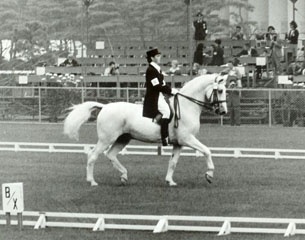
The story starts June 1949 in the North of Germany. Near the town of Husum, famous as the birth village of German poet Theodor Storm, two horses were grazing happily in separate fields not far from each other. One, a young Lippizaner stallion, damaged the fence looking for an amorous adventure which it quickly found with the other horse nearby, a noble Holsteiner mare.
What was the typical accident in the field became the conception of Stephan, one of Switzerland's most successful dressage horses in the 1960s and a two time Olympic medallist.Stephan's involuntary "breeder" Johannes Hansen from Wittbek near Husum, hadn't a clue that his Holstein mare called "Stute" (=mare) was covered by the young intruder, though he wondered a bit why she became fatter each month while eating the same amount.
"Wittbek-Hannes" as everybody in the village nicknamed the popular owner of an inn was a bit surprised to find his fine mare, which pulled the milk carriage every day, with a little black colt on the ground in May 1950.
Nobody had written down the exact date of birth of the horse, but Wittbek-Hannes immediately realised why the fence of his mare was damaged about a year ago and who had been the intruder!
The little foal was called "Schimmel" (grey horse) because Wittbek-Hannes' inn was called „Schimmelreiter“ (Grey Horse Rider) based on a novel by Theodor Storm, the most famous celebrity of the region.
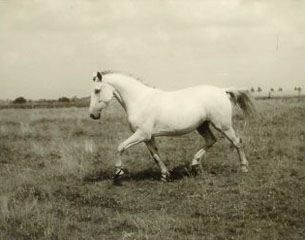 To his owner the combination of Holstein and Lippizaner blood was ideal to refresh Holsteiner breeding and so he traveled to the Elmshorn licensing when „Schimmel“ was three. As much as he was convinced of the quality of his 3-year old the licensing commission wasn't! After two more disappointing and failed tries to get his stallion approved Wittbek-Hannes 'retired' his young grey to the fields where he grazed amidst a herd of cows.
To his owner the combination of Holstein and Lippizaner blood was ideal to refresh Holsteiner breeding and so he traveled to the Elmshorn licensing when „Schimmel“ was three. As much as he was convinced of the quality of his 3-year old the licensing commission wasn't! After two more disappointing and failed tries to get his stallion approved Wittbek-Hannes 'retired' his young grey to the fields where he grazed amidst a herd of cows.
Schimmel loved to play with them, but this did harm to the milk production so Wittbek-Hannes tied two thin chains of 50 cm length around the forelegs of his horse. Every time the stallion chased the cows the chains hit his hindlegs and hurt him. As a consequence he sustained scars high up to the hocks which were visible until his last days.
After Schimmel's dam was retired from her job pulling the milk carriage her son stepped in and every morning he delivered the milk to the station. Aged 6 Schimmel was gelded because he had become a bit of a handful for his aging owner.
Only a year later Schimmel's future was decided when a 14-year old Swiss girl told her father that her biggest wish was to get a horse of her own. Of course many young girls in the past and nowadays have that wish, but in that case it had a different meaning.
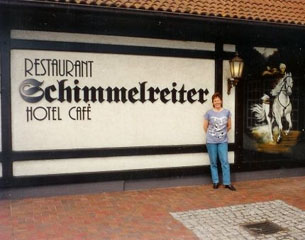 Marianne Gossweiler from Schaffhausen was the daughter of a horse dealer and was used to the coming and going of horses in their stable. But after being lunged for more than a year to learn the correct seat and following her first little successes in shows on borrowed horses she was seeking for a horse to keep. Her father was aware of this and when he was traveling to Schleswig-Holstein to buy horses for his trade he discovered Schimmel at Wittbek-Hannes' place through a trusted agent who knew he was on the lookout for his daughter.
Marianne Gossweiler from Schaffhausen was the daughter of a horse dealer and was used to the coming and going of horses in their stable. But after being lunged for more than a year to learn the correct seat and following her first little successes in shows on borrowed horses she was seeking for a horse to keep. Her father was aware of this and when he was traveling to Schleswig-Holstein to buy horses for his trade he discovered Schimmel at Wittbek-Hannes' place through a trusted agent who knew he was on the lookout for his daughter.
"The grey had the proper age and seemed to be okay," Marianne Fankhauser (née Gossweiler) told Eurodressage. "According to his teeth he actually was 7, he was sound and not expensive. Hannes wanted 1250 DM (approx. 650 Euro). My father didn't mind the scars and the missing pedigree papers."
So Schimmel changed owners by handshake and was sent on the long journey from the North of Germany to the North of Switzerland by train. After three days on the train together with six selected horses for trade the white gelding arrived at his destination: Schaffhausen.
"When my future horse arrived at the station I was quite disappointed. He looked rather like a carriage horse and was more than fat! I was even more disappointed when I neared him to welcome him and his ears flattened immediately. I held back my tears, but my father knew me too well not to notice my disappointment. But when he looked me in the eye and reassured me the grey is the right horse for me I believed him," Marianne reminisced.
She led her „horse to keep“ from the station across the town and was impressed how unimpressed he was by the squeaking trams, very unlike the other new arrivals which spooked in front of him and tugged their handlers along the pavement.
Marianne cannot remember why, but in 1957 the grey finally got a real name and was christened "Stephan," the name under which he would become famous. Though she came from a horsey background and had quite some experience compared to other girls her age the 14-year old didn't have the easiest time with her first horse at the beginning of their partnership.
Probably because of his youth Stephan definitely wasn't a horse to cuddle and pamper. Every time somebody neared him he flattened his ears, swooshed his tail and lifted one of his hindlegs. He didn't like to be touched or stroked without reason, but he was obedient when somebody came with the halter, grooming kit, saddle, bridle or blanket.
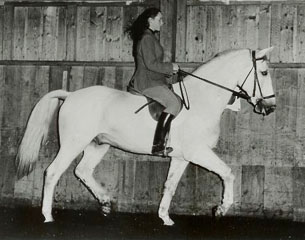 Moreover Stephan was a very strong and independent personality, in particular for a young girl. "First he very often tried to show me that he was the boss and I had to accept the subordinate role," said Marianne. "My father then put him on a diet. No more hard feed for quite some time and we educated him consequently and strictly. Horses need a ranking to feel secure and they are stressed if they don't have a human to lead them. This is a fact many riders of today do not consider enough. Anyway Stephan never doubted it that he was only a little bit behind us in the hierarchy."
Moreover Stephan was a very strong and independent personality, in particular for a young girl. "First he very often tried to show me that he was the boss and I had to accept the subordinate role," said Marianne. "My father then put him on a diet. No more hard feed for quite some time and we educated him consequently and strictly. Horses need a ranking to feel secure and they are stressed if they don't have a human to lead them. This is a fact many riders of today do not consider enough. Anyway Stephan never doubted it that he was only a little bit behind us in the hierarchy."
Fifty years ago there were no Juniors nor Young Riders divisions like today and Marianne's aim with Stephan hadn't been something in particular apart from "learning to ride properly." That this goal would lead both to Olympic Games nobody could foresee in those early days.
At that time Marianne's father drove two times a week to the German town of Rottweil at the border of the Black Forest to pick up Wilhelm Schmid, who became Marianne's first trainer. She almost never rode without an attendant who taught her how to use the aids in the right way. Stephan's strong character and his sometimes stallion-like attitude, a consequence of his late castration, weren't always easy to handle for a teenager, but never did any of Marianne's trainers allowed her to blame the horse for the occurring problems.
„It was always the rider to blame when difficulties arose. The rider, because he wasn't able to tell the horse clearly enough what he want him to do. A horse can only react. Only the rider is able to improve mistakes by giving the correct understandable aids over and over again until the horse understands it and shows the desired reaction," Marianne explained.
The classical art of riding was Marianne's only (invisible) manual to ride Stephan. There were no tricks applied, no special tack like draw reins used. One simply had to go on and persist.
"I have never imagined a life with my first horse so exhausting and often frustrating. I never fell off Stephan, but I shed quite some tears of disappointment during our journey to learn the art of riding properly."
Two years after both had started working together Marianne was able to harvest the fruit of their labour in 1959. They won every L- level dressage competition they entered and showed the small Swiss dressage world their talent for the first time.
In 1960 both had to start at M-level because the Swiss dressage regulations didn't allow a rider to start at the same level after four or more wins in one season. Even at a step up the ladder the white Lippizaner crossbred and his 17-year old rider remained victorious in every M-test.
Training at home in Schaffhausen was now done by the famous cavalry rider Gustav Fischer from the EMPFA in Berne. He came every three weeks to coach the promising pair. Fischer had represented his country in the 1952 and 1956 Olympic Games and had won the individual Olympic silver medal in 1960 on a huge Swedish gelding called Wald, which was to become Stephan's traveling and team companion later on.
Fischer was very good in the piaffe-passage work and trained Stephan in these important exercises. "We trained the piaffe before the passage and only when Stephan's hindlegs were strong enough to carry the weight and step under," Marianne explained. "We collected the horse from behind and developed half steps. And then it developed quite naturally riding against the stilled hand with many small half halts until we had the first steps. Everything was intended to develop under and through the rider so we never trained piaffe from the ground. Also Gusti Fischer never gave any aids from the ground except sometimes a click with his tongue. When a horse learns the first piaffe steps that way it learns very easily what the rider wants in this exercise."
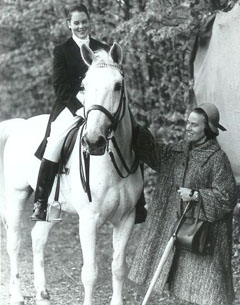 Two times a year for three weeks in a row at the beginning 1960s Marianne and Stephan had the opportunity to train with Karl Becker, a former member of the famous Hanover Cavalry School, when he visited the Gossweilers in Switzerland.
Two times a year for three weeks in a row at the beginning 1960s Marianne and Stephan had the opportunity to train with Karl Becker, a former member of the famous Hanover Cavalry School, when he visited the Gossweilers in Switzerland.
Though the pair didn't have a trainer present every day, they very rarely rode without somebody observing their work. Marianne's mother attended every of her daughter's sessions. She wrote down every word and over the years learned to realise the coherence and to help her daughter. She read classical books by Gustav Steinbrecht, Wilhelm Müseler or Waldemar Seunig and became Marianne's greatest help but also her greatest critic.
"In my everyday training I had to deal with my mum," Marianne admitted. "Often I was satisfied with my work, but she wasn't! She had a great perseverance and went on until everything was okay. She was phenomenal! My mother deserves the largest share of our successes. She was one of the very rare people who exactly knew what they were talking about though she was only a pleasure rider."
In 1961 Stephan and Marianne had their first S-level start and they also competed at smaller shows at the Swiss-German border in Bad Dürrheim, Donaueschingen or Villingen- Schwenningen against German riders. Only a year later they had their first start at the international show at Ludwigsburg near Stuttgart at S-level before quite easily switching to Grand Prix level.
In the 1960s the number of international shows (CDI / CDIO) was very limited compared to today's standard. There were only a few like at Aachen, Rotterdam, Paris or Copenhagen and the opportunity to meet the best riders was limited. The amount of international competitors was similarly assessable and every newcomer drew attention.
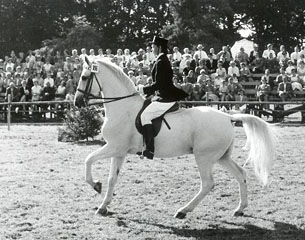 So when the 20-year old Marianne and her 166 cm tall grey horse were sent to their first international Grand Prix show in Paris in 1963 the spotlight was on them. Stephan impressed with his wonderful settled canter pirouettes and his high rideability and was nominated for the unofficial European Championships in Copenhagen later that year, where Marianne's companion Henri Chammartin won his first European title on the marvelous chestnut Wolfdietrich.
So when the 20-year old Marianne and her 166 cm tall grey horse were sent to their first international Grand Prix show in Paris in 1963 the spotlight was on them. Stephan impressed with his wonderful settled canter pirouettes and his high rideability and was nominated for the unofficial European Championships in Copenhagen later that year, where Marianne's companion Henri Chammartin won his first European title on the marvelous chestnut Wolfdietrich.
Switzerland didn't send a team to Copenhagen, but when the Olympics in Tokyo neared team selection became an issue again. Stephan, then 14, still only in his second year at Grand Prix level, was a possibility, but he and his rider were very inexperienced and never before had a woman joined a Swiss summer Olympic team, let alone in dressage!
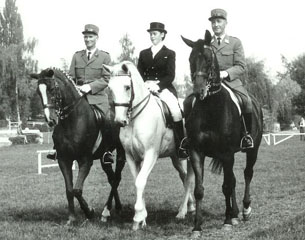 In the two selection trails in Berne and Lausanne Marianne and her grey managed to finish third behind the EMPFA riders Chammartin and Fischer and ahead of the third EMPFA representative, Gottfried Trachsel, who had joined the team in 1952 and 1956. So the little sensation was perfect: Being the youngest team member ever at 21 and the first woman in Swiss dressage history Marianne and her "horse to keep" had made the Olympics.
In the two selection trails in Berne and Lausanne Marianne and her grey managed to finish third behind the EMPFA riders Chammartin and Fischer and ahead of the third EMPFA representative, Gottfried Trachsel, who had joined the team in 1952 and 1956. So the little sensation was perfect: Being the youngest team member ever at 21 and the first woman in Swiss dressage history Marianne and her "horse to keep" had made the Olympics.
When asked if this was also considered a sensation by the public, Marianne confirmed it: "For the public me and my grey had achieved something great and almost everybody was happy about it. I was immediately accepted as a fully respected team member and Henri and Gusti offered me to call them by their first name. Now I was one of them, no problem!"
The Swiss horses flew to Tokyo without incident accompanied by their riders. Marianne usually had somebody from her father's stable with her at shows to help her with Stephan's grooming, but at official championships the grooms of the EMPFA not only took care of Fischer's and Chammartin's horses, but also of hers. Though Stephan was a horse which very easily chased strangers out of his box by flattening his ears and showing his teeth he was quite polite to people he knew and who entered his stable in a determined way.
In Tokyo the environmental conditions to compete in were not the easiest ones on the day of the Grand Prix. A storm was brewing and one could have wished better circumstances to have an Olympic debut. Stephan wasn't the spookiest of dressage horses, but of course an electrifying atmosphere had also an effect on him. However as soon as he entered the dressage arena he completely concentrated on his rider and showed a brilliant performance to finish 7th, just out of the rankings to reach the Grand Prix Spécial in that time.
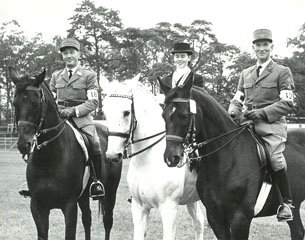 Marianne knows why they were both able to make such an amazing debut on the Olympic stage. "Obviously Stephan had the ability to concentrate incredibly during a performance and it looked like he was aware of the special situations. Actually he hadn't the ability, but I had and because of it I was able to support him with very concentrated aids and he reacted to them. Many people believe a horse knows when it is a big championship. But a horse isn't a human what we forget so easily nowadays. Stephan's obedience was the result of his rideability and his "Durchlässigkeit" (throughness, suppleness and submission)."
Marianne knows why they were both able to make such an amazing debut on the Olympic stage. "Obviously Stephan had the ability to concentrate incredibly during a performance and it looked like he was aware of the special situations. Actually he hadn't the ability, but I had and because of it I was able to support him with very concentrated aids and he reacted to them. Many people believe a horse knows when it is a big championship. But a horse isn't a human what we forget so easily nowadays. Stephan's obedience was the result of his rideability and his "Durchlässigkeit" (throughness, suppleness and submission)."
So their first Olympic experience ended with a team silver medal. Funnily in Tokyo in 1964 only one medal for every team was provided and gentlemen as they were Fischer and Chammartin handed this medal to Marianne.
Stephan and Marianne continued their successful international career over the next years. At the 1965 European Championships they won a team silver and in 1967 team bronze. In between were the first dressage World Championships on home turf at EMPFA Berne. The event not only included another team silver medal, but according to Marianne her fondest memory of a show was when she and Stephan won the freestyle division.
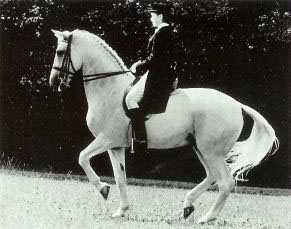 In their last year of competition together Stephan was 18 years old, but still in a very good shape. They were again nominated for the Olympic dressage team for the Games in Mexico-City. The Swiss team had been identical since 1964! Though it was quite a hard fight between Stephan and an upcoming thoroughbred called Merry Boy, ridden by the then unknown Christine Stückelberger, the wonderful grey made the team for the 5th time consecutively! In Mexico-City the pair placed 10th individually and contributed to the Swiss team bronze medal behind Germany and a strong Soviet Union.
In their last year of competition together Stephan was 18 years old, but still in a very good shape. They were again nominated for the Olympic dressage team for the Games in Mexico-City. The Swiss team had been identical since 1964! Though it was quite a hard fight between Stephan and an upcoming thoroughbred called Merry Boy, ridden by the then unknown Christine Stückelberger, the wonderful grey made the team for the 5th time consecutively! In Mexico-City the pair placed 10th individually and contributed to the Swiss team bronze medal behind Germany and a strong Soviet Union.
In their time together Stephan was taken care of, but not wrapped in the proverbial cotton wool. He was regularly hacked out in the company of other horses and enjoyed simulated races with his horsey colleagues. "Stephan could be incredibly fast. If he really took off I almost couldn't feel a move in the saddle. His nose in front and with ears flattened he won almost every single 'race' we did," his rider remembered.
Moreover now and then, when no other horse was available, Stephan had to step in and drag the ground of the indoor arena to make it even again.
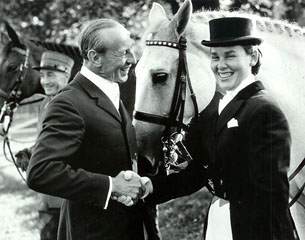 A man Marianne looked up to and who finished ahead of her at championships was Dr. Reiner Klimke, a young man from Germany who had become a dear friend in the meantime. Marianne got to know him first at the CDI Paris in 1963 and over the years a friendship between her and the Klimke couple had developed. Before the Olympic Games in Mexico Marianne and her horse had been to Münster to train with Dr. Klimke.
A man Marianne looked up to and who finished ahead of her at championships was Dr. Reiner Klimke, a young man from Germany who had become a dear friend in the meantime. Marianne got to know him first at the CDI Paris in 1963 and over the years a friendship between her and the Klimke couple had developed. Before the Olympic Games in Mexico Marianne and her horse had been to Münster to train with Dr. Klimke.
"Reiner rode Stephan two times during our stay in Münster. He wanted to see how Stephan felt like. Both moved in the indoor arena like they had been longtime partners. They performed everything and nobody would have thought Reiner had been on the horse for the very first time. When Reiner dismounted he told me what an excellently ridden and good horse I had. I was even more happy about this compliment than about a victory at a show."
After the Olympics Stephan retired from competition. There was no farewell ceremony like nowadays with celebrated horses, but the news went on air on the Swiss radio and also in the newspapers because the young rider and her white horse had been quite an attraction on the Swiss sports scene.
But what to do with a sound and healthy horse in his retirement? Dr. Reiner Klimke knew a solution for Stephan. "Reiner asked me to send Stephan over for one of his pupils to learn from and feel a highly trained dressage horse. The agreement was that the Klimkes and Hans Jürgen Meyer, their pupil, were allowed to ride Stephan as long as he would no longer be competed." So Stephan traveled back to the north and remained in the famous St.Georg-stable in Münster until 1972.
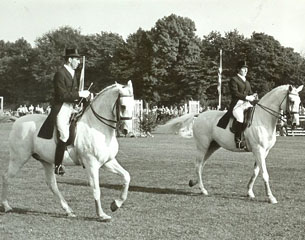 On several occasions he returned into the spotlights when Dr. Reiner Klimke and his wife Ruth or his sister Grete performed a pas de deux. Dr. Klimke then rode Harry Boldt's former Olympic horse, the retired grey Remus and the women rode Stephan, which created a very nice picture to the audience.
On several occasions he returned into the spotlights when Dr. Reiner Klimke and his wife Ruth or his sister Grete performed a pas de deux. Dr. Klimke then rode Harry Boldt's former Olympic horse, the retired grey Remus and the women rode Stephan, which created a very nice picture to the audience.
The secret behind Stephan's excellent health and why he was able to stay sound and fit for so long, was according to Marianne the fact that Stephan had only started seriously working at the age of 7. His growth had finished and his limbs were very strong. "His training was right and logical from the beginning, he hadn't been overasked, neither physically nor mentally. And he had inherited much from his Lippizaner father, a breed known for its hardness."
After coming back from Germany Stephan was 22 and still in a good state of health. Because the stable of Marianne's father in Schaffhausen no longer existed she decided to give her old horse to her friend Katja who lived near Berne. She had a nice farm with big fields. Stephan's new task was to be the babysitter of the foals there. "He was like an uncle to them and showed them how to behave if their mothers failed."
"When my friend Katja was hacking her horses he accompanied them. First he went behind or next to them and on the way home he always had to walk in front. If Katja worked one of her horses in the outdoor arena Stephan also accompanied them and was grazing as long as they worked before returning home with them. Later he carried Katja's little daughter Ewa patiently around," Marianne reported.
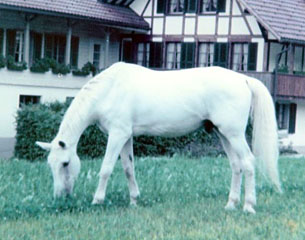 In 1979 Stephan was 29 and after a colic he sustained laminitis and sadly had to be put down at this respected age. Stephan had been Marianne Fankhauser's first horse and also her only international Grand Prix horse.
In 1979 Stephan was 29 and after a colic he sustained laminitis and sadly had to be put down at this respected age. Stephan had been Marianne Fankhauser's first horse and also her only international Grand Prix horse.
She was only 26 years when she said goodbye to competitive dressage.
"It was a very short time, but I often think back to it. Because I wanted to ride properly I was able to realise dreams with my first "horse to keep," Stephan," she concluded.
Article by Silke Rottermann
Photos courtesy: Marianne Fankhauser
Related Links
Bonheur xx, From Race Track to Olympic Dressage Arena
Antoinette, Josef Neckermann's Prima Donna